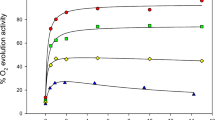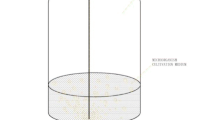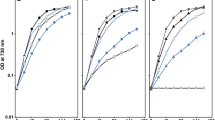Abstract
The unicellular green alga Chlamydomonas reinhardtii possesses a CO2-concentrating mechanism. In order to measure the CO2 permeability coefficients of the plasma membranes (PMs), carbonic anhydrase (CA) loaded vesicles were isolated from C. reinhardtii grown either in air enriched with 50 mL CO2 · L−1} (high-Ci cells) or in ambient air (350 μL CO2 · L−1}; low-Ci cells). Marker-enzyme measurements indicated less than 1% contamination with thylakoid and mitochondrial membranes, and that more than 90% of the PMs from high and low-Ci cells were orientated right-side-out. The PMs appeared to be sealed as judged from the ability of vesicles to accumulate [14C]acetate along a proton gradient for at least 10 min. Carbonic anhydrase-loaded PMs from high and low-Ci cells of C. reinhardtii were used to measure the exchange of 18O between doubly labelled CO2 (13C18O2) and H2O in stirred suspensions by mass spectrometry. Analysis of the kinetics of the 18O depletion from 13C18O2 in the external medium provides a powerful tool to study CO2 diffusion across the PM to the active site of CA which catalyses 18O exchange only inside the vesicles but not in the external medium (Silverman et al., 1976, J Biol Chem 251: 4428–4435). The activity of CA within loaded PM vesicles was sufficient to speed-up the 18O loss to H2O to 45360–128800 times the uncatalysed rate, depending on the efficiency of CA-loading and PM isolation. From the 18O-depletion kinetics performed at pH 7.3 and 7.8, CO2 permeability coefficients of 0.76 and 1.49·10−3} cm·s−1}, respectively, were calculated for high Ci cells. The corresponding values for low-Ci cells were 1.21 and 1.8·10−3} cm·s−1}. The implications of the similar and rather high CO2 permeability coefficients (low CO2 resistance) in high and low-Ci cells for the COi-concentrating mechanism of C. reinhardtii are discussed.
Similar content being viewed by others
Abbreviations
- AZA:
-
acetazolamide
- CA:
-
carbonic anhydrase
- CCCP:
-
carbonylcyanide m-chlorophenylhydrazone
- CCM:
-
CO2concentrating mechanism
- Ci :
-
inorganic carbon
- IDPase:
-
inosine diphosphate
- P:
-
permeability coefficient
- PM:
-
plasma membrane
- Rubisco:
-
ribulose-1,5-bisphosphate carboxylase/oxygenase
References
Amoroso G, Weber C, Sültemeyer D, Fock HP (1996) Intracellular carbonic anhydrase activities in Dunaliella tertiolecta (Butcher) and Chlamydomonas reinhardtii (Dangeard) in relation to inorganic carbon concentration during growth: further evidence for the existence of two distinct carbonic anhydrases associated with the chloroplasts. Planta 199: 177–184
Badger MR (1987) The CO2 concentrating mechanism in aquatic phototrophs. In: Hatch MD, Boardman NK eds The biochemistry of plants: A comprehensive treatise. Academic Press, New York, vol 10, pp 132–218
Badger MR, Price GD (1992) The CO2 concentrating mechanism in cyanobacteria and micro algae. Physiol Plant 84: 606–615
Badger MR, Price GD (1994) The role of carbonic anhydrase in photosynthesis. Annu Rev Plant Physiol Plant Mol Biol 45: 369–392
Badger MR, Kaplan A, Berry JA (1980) Internal inorganic carbon pool in Chlamydomonas reinhardtii: Evidence for a carbon dioxide concentrating mechanism. Plant Physiol 66: 407–413
Badger MR, Palmqvist K, Yu J-W (1994) Measurements of CO2 and HCO -3 fluxes in cyanobacteria and microalgae during steady state photosynthesis. Physiol Plant 90: 529–536
Baier M, Hartung W (1988) Movement of abscisic acid across the plasmalemma and the tonoplast of guard cells of Valerianella locusta. Bot Acta 101: 332–337
von Caemmerer S, Colman JR, Berry JA (1983) Control of photosynthesis by RuBP concentration: studies with high and low CO2 adapted cells of Chlamydomonas reinhardtii. Carnegie Inst Washington Year bk 82: 91–95
Gimmler H, Weiss C, Baier M, Hartung W (1990) The conductance of the plasmalemma for CO2. J Exp Bot 41: 785–795
Gutknecht J, Bisson MA, Tosteson FC (1977) Diffusion of carbon dioxide through lipid bilayer membranes. J Gen Physiol 69: 779–794
Husic HD, Marcus CA (1994) Identification of intracellular carbonic anhydrase in Chlamydomonas reinhardtii with a carbonic anhydrase-directed photoaffinity label. Plant Physiol 105: 133–139
Husic HD, Kitayama M, Togasaki RK, Moroney JV, Morris KL, Tolbert NE (1989) Identification of intracellular carbonic anhydrase in Chlamydomonas reinhardtii which is distinct from the periplasmic form of the enzyme. Plant Physiol 89: 904–909
Kaplan A, Schwarz R, Lieman-Hurwitz J, Ronen-Tarazi M, Reinhold L (1994) Physiological and molecular studies on the response of cyanobacteria to changes in the ambient inorganic carbon concentration. In: Bryant DA (ed) The molecular biology of cyanobacteria. Kluver Academic Publishers, Netherlands, pp 469–485
Karsson J, Hiltonen T, Husic HD, Ramazanov Z, Samuelsson G (1995) Intracellular carbonic anhydrase of Chlamydomonas reinhardtii. Plant Physiol 109: 533–539
Larsson C, Widell S, Kjellbom P (1987) Preparation of high-purity plasma membranes. Methods Enzymol 148: 558–568
McKay RML, Gibbs SB (1991) Composition and function of pyrenoids: cytochemical and immunocytochemical approaches. Can J Bot 69: 1040–1052
Moroney JV, Husic HD, Tolbert NE (1985) Effect of carbonic anhydrase inhibitors on inorganic carbon accumulation by Chlamydomonas reinhardtii. Plant Physiol 79: 177–183
Moroney JV, Kitayama M, Tokasaki RT, Tolbert NE (1987) Evidence for inorganic carbon transport by intact chloroplasts of Chlamydomonas reinhardtii. Plant Physiol 83: 460–463
Palmqvist K, Yu J-W, Badger MR (1994) Carbonic anhydrase activity and inorganic carbon fluxes in low and high Ci of Chlamydomonas reinhardtii and Scenedesmus obliquus. Physiol Plant 90: 537–547
Porra RJ, Thompson W-A, Kriedemann PE (1989) Determination of accurate extinction coefficients and simultaneous equations for assaying chlorophylls a and b extracted with four different solvents: verification of the concentration of chlorophyll standards by atomic absorption spectroscopy. Biochim Biophys Acta 975: 384–394
Raven JA (1988) Algae. In: Baker DA, Hall JL (eds) Solute transport in plant cells and tissues. Longman, Harlow, 166–219
Raven JA, Beardall J, Johnston A (1982) Inorganic carbon transport in relation to H+ transport at the plasmalemma of photosynthetic cells. In: Marmé E, Marré R, Hertel S (eds) Plasmalemma and tonoplast: their function in the plant cell. Elsevier Biomédical Press, pp 41–47
Silverman DN, Tu C, Wynns GC (1976) Depletion of 18O from C18O2 in erythrocyte suspensions. J Biol Chem 251: 4428–4435
Spalding MH, Ogren WL (1982) Photosynthesis is required for induction of the CO2 concentrating system in Chlamydomonas reinhardtii. FEBS Lett 145: 41–44
Spalding MH, Portis AR (1985) A model of carbon dioxide assimilation in Chlamydomonas reinhardtii. Planta 164: 308–320
Sültemeyer DF, Klöck G, Kreuzberg K, Fock HP (1988) Photosynthesis and apparent affinity for dissolved inorganic carbon by cells and chloroplasts of Chlamydomonas reinhardtii grown at high and low CO2 concentrations. Planta 176: 256–260
Sültemeyer DF, Miller AG, Espie GS, Fock HP, Canvin DT (1989) Active CO2 transport by the green alga Chlamydomonas reinhardtii. Plant Physiol 89: 1213–1219
Sültemeyer DF, Fock HP, Canvin DT (1990) Mass spectrometric measurement of intracellular carbonic anhydrase activity in high and low Ci cells of Chlamydomonas. Plant Physiol 94: 1250–1257
Sültemeyer DF, Fock HP, Canvin DT (1991) Active uptake of inorganic carbon by Chlamydomonas: evidence for a simultaneous transport of HCO -3 and CO2 and characterisation of active transport. Can J Bot 69: 995–1002
Sültemeyer D, Biehler K, Fock HP (1993a) Evidence for the contribution of pseudocyclic photophosphorylation to the energy requirement of the mechanism for concentrating inorganic carbon in Chlamydomonas. Planta 189: 235–242
Sültemeyer D, Schmidt C, Fock HP (1993b) Carbonic anhydrase in higher plants and mircroorganisms. Physiol Plant 88: 179–190
Sültemeyer D, Amoroso G, Fock H (1995) Induction of intracellular carbonic anhydrases during the adaptation to low inorganic carbon concentrations in wild-type and ca-1 mutant cells of Chlamydomonas reinhardtii. Planta 196: 217–224
Tu C, Wynns GC, McMurray RE, Silverman DN (1978) CO2 Kinetics in red blood cell suspensions measured by 18O exchange. J Biol Chem 253: 8178–8184
Tu C, Acedo-Duncan M, Wynns GC, Silverman DN (1986) Oxygen 18 exchange as a measure of acessibility of CO2 and HCO -3 to carbonic anhydrase in Chlorella vulyaris (UTEX 263). Plant Physiol 80: 997–1001
Tubbe A, Buckhout TJ (1992) In vitro analysis of the H+-hexose symporter on the plasma membrane of sugarbeets (Beta vulgaris L.). Plant Physiol 99: 945–951
Weibel ER, Losa G, Bolender RP (1976) Stereological method for estimating relative membrane surface area in freeze-fracture preparations os subcellular fractions. J Microsc 107: 255–266
Widell S, Larsson C (1990) A critical evaluation of markers used in plasma-membrane purification. In: Larsson C, Moller IM (eds) The plant plasma membrane. Springer, Berlin, pp 16–39
Yokota A, Kitaoka S (1985) Correct pK values for dissociation constant of carbonic acid lower the reported Km values of ribulose bisphosphate carboxylase to half. Presentation of a nomograph and an equation for determining the pK values. Biochem Biophys Res Comm 131: 1075–1079
Yokota A, Iwaki T, Miura K, Wadano A, Kitaoka S (1987) Model for the relationships between CO2-concentrating mechanism, CO2 fixation, and glycolate synthesis during photosynthesis in Chlamydomonas reinhardtii. Plant Cell Physiol 28: 1363–1376
Zenvirth D, Kaplan A (1981) Uptake and efflux of inorganic carbon in Dunaliella tertiolecta. Planta 152: 8–12
Author information
Authors and Affiliations
Corresponding author
Additional information
We are grateful to Prof. H.P. Fock (FB Biolgie, Universität Kaiserslautern, Germany) for providing us with the MS facilities, laboratory equipment and critically reading the manuscript. We wish to thank Prof. T. J. Buckhout (Angewandte Botanik, Humbold Universitat, Berlin, Germany) for his help during isolation of PMs and Drs. A. Tubbe (FB Biologie, Universitat Kaiserslautern, Germany) and D. Kramer (Institut für Botanik der Technischen Hochschule, Darmstadt, Germany) for the measurement of radioactive acetate uptake and support with freeze fracture and electron microscopy, respectively. In addition, we thank Drs. M. R. Badger and S. von Caemerer (Research School of Biological Sciences, The Australian National University, Canberra, Australia) for many helpful comments during preparation of the manuscript. Part of this work was supported by a research fellowship from the Deutsche Forschungsgemeinschaft awarded to D.S.
Rights and permissions
About this article
Cite this article
Sültemeyer, D., Rinast, KA. The CO2 permeability of the plasma membrane of Chlamydomonas reinhardtii: mass-spectrometric 18O-exchange measurements from 13C18O2 in suspensions of carbonic anhydrase-loaded plasma-membrane vesicles. Planta 200, 358–368 (1996). https://doi.org/10.1007/BF00200304
Received:
Accepted:
Issue Date:
DOI: https://doi.org/10.1007/BF00200304




